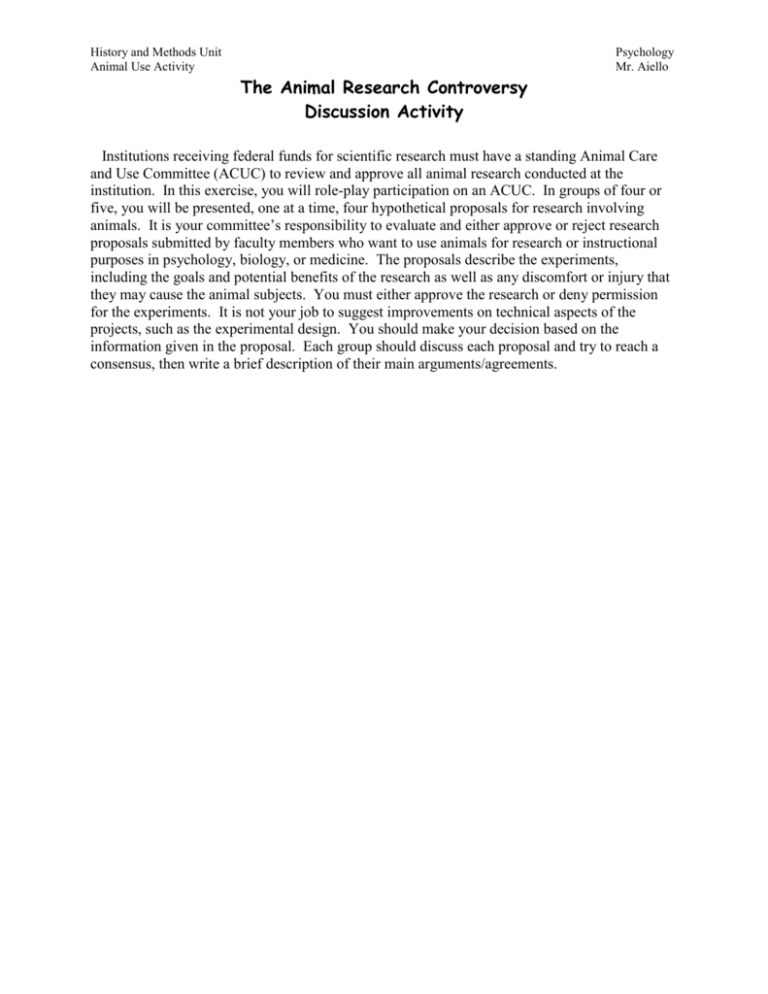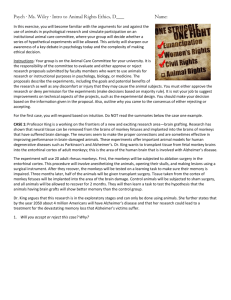Animal Research Proposals - School District of Clayton
advertisement

History and Methods Unit Animal Use Activity Psychology Mr. Aiello The Animal Research Controversy Discussion Activity Institutions receiving federal funds for scientific research must have a standing Animal Care and Use Committee (ACUC) to review and approve all animal research conducted at the institution. In this exercise, you will role-play participation on an ACUC. In groups of four or five, you will be presented, one at a time, four hypothetical proposals for research involving animals. It is your committee’s responsibility to evaluate and either approve or reject research proposals submitted by faculty members who want to use animals for research or instructional purposes in psychology, biology, or medicine. The proposals describe the experiments, including the goals and potential benefits of the research as well as any discomfort or injury that they may cause the animal subjects. You must either approve the research or deny permission for the experiments. It is not your job to suggest improvements on technical aspects of the projects, such as the experimental design. You should make your decision based on the information given in the proposal. Each group should discuss each proposal and try to reach a consensus, then write a brief description of their main arguments/agreements. History and Methods Unit Animal Use Activity Psychology Mr. Aiello Animal Research Proposals Proposal 1 Professor King is a psychobiologist working on the frontiers of a new and exciting area of neuroscience, brain grafting. Research has shown that neural tissue can be removed from the brains of monkey fetuses and implanted into the brains of monkeys that have suffered brain damage. The neurons seem to make the proper connections and are sometimes effective in improving performance in brain-damaged animals. These experiments offer important animal models for human degenerative diseases such as Parkinson’s and Alzheimer’s. Dr. King wants to transplant tissue from fetal monkey brains into the entorhinal cortex of adult monkeys; this is the area of the human brain that is involved with Alzheimer’s disease. The experiment will use 20 adult rhesus monkeys. First, the monkeys will be subjected to ablation surgery in the ehtorhinal cortex. This procedure will involve anesthetizing the animals, opening their skulls, and making lesions using a surgical instrument. After they recover, the monkeys will be tested on a learning task to make sure their memory is impaired. Three months later, half of the animals will be given transplant surgery. Tissue taken from the cortex of monkey fetuses will be implanted into the area of the brain damage. Control animals will be subjected to sham surgery, and all animals will be allowed to recover for 2 months. They will then learn a task to test the hypothesis that the animals having brain grafts will show better memory than the control group. Dr. King argues that this research is in the exploratory stages and can only be done using animals. She further states that by the year 2010, about 2.5 million Americans will have Alzheimer’s disease and that her research could lead to a treatment for the devastating memory loss that Alzheimer’s victims suffer. History and Methods Unit Animal Use Activity Psychology Mr. Aiello Proposal 2 Your university includes a college of veterinary medicine. In the past, the veterinary students have practiced surgical techniques on dogs procured from a local animal shelter. However, there have been some objections to this practice, and the veterinary school wants the approval of your committee to continue this practice. They make the following points. 1. Almost all of these animals will eventually be killed at the animal shelter. It is wasteful of life to breed animals for the vet school when there is an ample supply of animals that are going to be killed anyway, either because their owners do not want them or they are homeless. 2. It costs at least 10 times as much to raise purebred animals for research purposes; this money could be better used to fund research that would benefit many animals. 3. Research with dogs from animal shelters and the practice surgeries will, in the long run, aid the lives of animals by training veterinarians and producing treatments for diseases that afflict animals. A local group of animal welfare activists has urged your committee to deny the veterinary school’s request. They argue that the majority of these animals are lost or stolen pets, and it is tragic to think that the dog you have grown to love will wind up on a surgical table or in an experiment. Furthermore, they claim that as people become aware that animals taken to shelters may end up in research laboratories, they will stop using the shelters. Finally, the activists point out that in countries such as England, veterinary students do not perform practice surgery; they learn surgical techniques in an extensive apprenticeship. History and Methods Unit Animal Use Activity Psychology Mr. Aiello Proposal 3 The Psychology Department is requesting permission from your committee to use 10 rats per semester for demonstration experiments in a physiological psychology course. The students will work in groups of three; each group will be given a rat. The students will first perform surgery on the rats. Each animal will be anethestized. Following standard surgical procedures, an incision will be made in the scalp and two holes drilled in the animal’s skull. Electrodes will be lowered into the brain to create lesions on each side. The animals will then be allowed to recover. Several weeks later, the effects of destroying this part of the animal’s brain will be tested in a shuttle avoidance task in which the animals will learn when to cross over an electrified grid. The instructor acknowledges that the procedure is a common demonstration and that no new scientific information will be gained from the experiment. He argues, however, that students taking a course in physiological psychology must have the opportunity to engage in small animal surgery and to see firsthand the effects of brain lesions.





